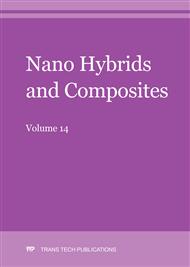[1]
Wang, R., Liu, Y., Li, B., Hsiao, B.S. and Chu, B. (2012), Electrospun Nanofibrous Membranes for High Flux Microfiltration, J Membr Sci, 392, pp.167-174.
DOI: 10.1016/j.memsci.2011.12.019
Google Scholar
[2]
Ebadi, S.V., Fakhrali, A., Gharehaghaji, A.A., Mazinani, S., Ranaei-Siadat, S.O. (2015).
Google Scholar
[3]
Ebadi, S.V., Fakhrali, A., Ranaei-Siadat, S.O., Gharehaghaji, A.A., Mazinani, S., Dinari, M. and Harati, J. (2015).
DOI: 10.1039/c5ra03456f
Google Scholar
[4]
Zamani, F., Amani‐Tehran, M., Latifi, M., Shokrgozar, M.A., & Zaminy, A. (2014), Promotion of Spinal Cord Axon Regeneration by 3D Nanofibrous Core–sheath Scaffolds, J Biomed Mater Res Part A, 102, pp.506-513.
DOI: 10.1002/jbm.a.34703
Google Scholar
[5]
Dalton, P.D., Klee, D., Möller, M. (2005), Electrospinning with Dual Collection Rings, Polymer, 46, p.611–614.
DOI: 10.1016/j.polymer.2004.11.075
Google Scholar
[6]
Fennessey, S.F., Farris, R.J. (2004), Fabrication of Aligned and Molecularly Oriented Electrospun Polyacrylonitrile Nanofibers and the Mechanical Behavior of Their Twisted Yarns, Polymer, 45, p.4217–4225.
DOI: 10.1016/j.polymer.2004.04.001
Google Scholar
[7]
Zhou, F.L., Gong, R.H. (2008), Review: Manufacturing Technologies of Polymeric Nanofibres and Nanofibre Yarns, Polym Int, 57, p.837–845.
DOI: 10.1002/pi.2395
Google Scholar
[8]
Liu, H., Leonas, K.K., Zhao, Y. (2010), Antimicrobial Properties and Release Profile of Ampicillin from Electrospun Poly(ε-caprolactone) Nanofiber Yarns,. J Eng Fiber Fabr, 5, pp.10-19.
DOI: 10.1177/155892501000500402
Google Scholar
[9]
Penchev, H., Paneva, D., Manolova, N., Rashkov, I. (2010), Hybrid Nanofibrous Yarns Based on N-Carboxyethylchitosan and Silver Nanoparticles with Antibacterial Activity Prepared by Self-bundling Electrospinning", Carbohydr Res, 345, pp.2374-2380.
DOI: 10.1016/j.carres.2010.08.014
Google Scholar
[10]
Haghighat, F. and Hosseini Ravandi, S.A. (2014), Mechanical properties and in vitro degradation of PLGA suture manufactured via electrospinning, Fiber Polym, 15, pp.71-77.
DOI: 10.1007/s12221-014-0071-9
Google Scholar
[11]
Lotus, A.F., Bender, E.T., Evans, E.A., Ramsier, R.D., Reneker, D.H. and Chase, G.G. (2008), Electrical, structural, and chemical properties of semiconducting metal oxide anofiber yarns, J Appl Phys, 103, p.024910. .
DOI: 10.1063/1.2831362
Google Scholar
[12]
Lotus, A.F., Bhargava, S., Bender, E.T., Evans, E.A., Ramsier, R.D., Reneker, D.H. and Chase, G.G. (2009), Electrospinning route for the fabrication of pn junction using nanofiber yarns, J Appl Phys, 106, p.014303.
DOI: 10.1063/1.3157206
Google Scholar
[13]
Khil, M.S., Bhattarai, S.R., Kim, H.Y., Kim, S.Z. and Lee, K.H. (2005), Novel Fabricated Matrix via Electrospinning for TissueEngineering, J Biomed Mater Res, 72, pp.117-124.
DOI: 10.1002/jbm.b.30122
Google Scholar
[14]
Pan, H., Li, L., Hu, L. and Cui, X. (2006), Continuous Aligned Polymer Fibers Produced By a Modified Electrospinning Method, Polymer, 47, pp.4901-4904.
DOI: 10.1016/j.polymer.2006.05.012
Google Scholar
[15]
Dabirian, F. and Hosseini, S.A. (2009), Novel Method For Nanofibre Yarn Production Using Two Differently Charged Nozzles, Fiber Text East Eur, 17, pp.45-47.
Google Scholar
[16]
Fakhrali, A., Ebadi, S.V., Gharehaghaji, A.A. (2014), Production of Core-Sheath Nanofiber Yarn Using Two Opposite Asymmetric Nozzles, Fiber Polym, 15, pp.2535-2540.
DOI: 10.1007/s12221-014-2535-3
Google Scholar
[17]
Barella, A., Manich, A. (1984), Diameter and Hairiness of Ring and Rotor Polyester-Cotton Blended Yarns, Text Res J, 54, pp.840-844.
DOI: 10.1177/004051758405401208
Google Scholar
[18]
Duket, K.E., Goswam, B.C., Ramey, H.H. (1979), Mechanical Properties of Cotton-Polyester Contribution of Inter-fiber Friction to Breaking Energy, Text Res J, 49, pp.262-267.
Google Scholar
[19]
Pan, N., Chen, K. (2000), Studying the Mechanical Properties of Blended Fibrous Structures Using a Simple Model, Text Res J, 70, pp.502-507. .
DOI: 10.1177/004051750007000606
Google Scholar
[20]
Hamburger, J.W. (1949), The Industrial Applications of the Stress-strain Relationship, J Text Inst, 40, pp.700-720.
Google Scholar
[21]
Nielsen, L.E. (1978), Predicting the Properties of Mixtures, Marcel Dekker New York.
Google Scholar
[22]
Marom, G., Fischer, S., Tuler, F.R., Wagner, H.D. (1978), Hybrid Effects in Composites; Conditions for Positive or Negative Effects Versus Rule of Mixtures, J Mater Sci, 13, pp.1419-1426.
DOI: 10.1007/bf00553194
Google Scholar
[23]
Baykal, P.D., Babaarslan, O., Erol, R., (2006), Prediction of Strength and Elongation Properties of Cotton/Polyester Blended OE Rotor Yarns, Fiber Text East Eur, 14, pp.18-21.
Google Scholar
[24]
Aghasian, S., Gharehaghaji, A.A., Ghane, M., Parsian, A. (2008), Investigation on The Properties of Blended Rotor-Spun Cotton/Polyester Yarn Using a Hybrid Model, J Text Inst, 99, pp.459-465.
DOI: 10.1080/00405000701608441
Google Scholar
[25]
Moghassem, A.R., Fakhrali, A., (2013), Comparative Study on the Effect of Blend Ratio on Tensile Properties of Ring and Rotor Cotton-Polyester Blended Yarns Using Concept of the Hybrid Effect, Fiber Polym, 14, pp.157-163.
DOI: 10.1007/s12221-013-0157-9
Google Scholar
[26]
Fakhrali, A., Ebadi, S.V., Gharehaghaji, A.A., Latifi, M., Moghassem, A. (2016), Analysis of Twist Level and Take-Up Speed Impact on the Tensile Properties of PVA/PA6 Hybrid Nanofiber Yarns, e-Polymers, 16, pp.125-135.
DOI: 10.1515/epoly-2015-0248
Google Scholar


